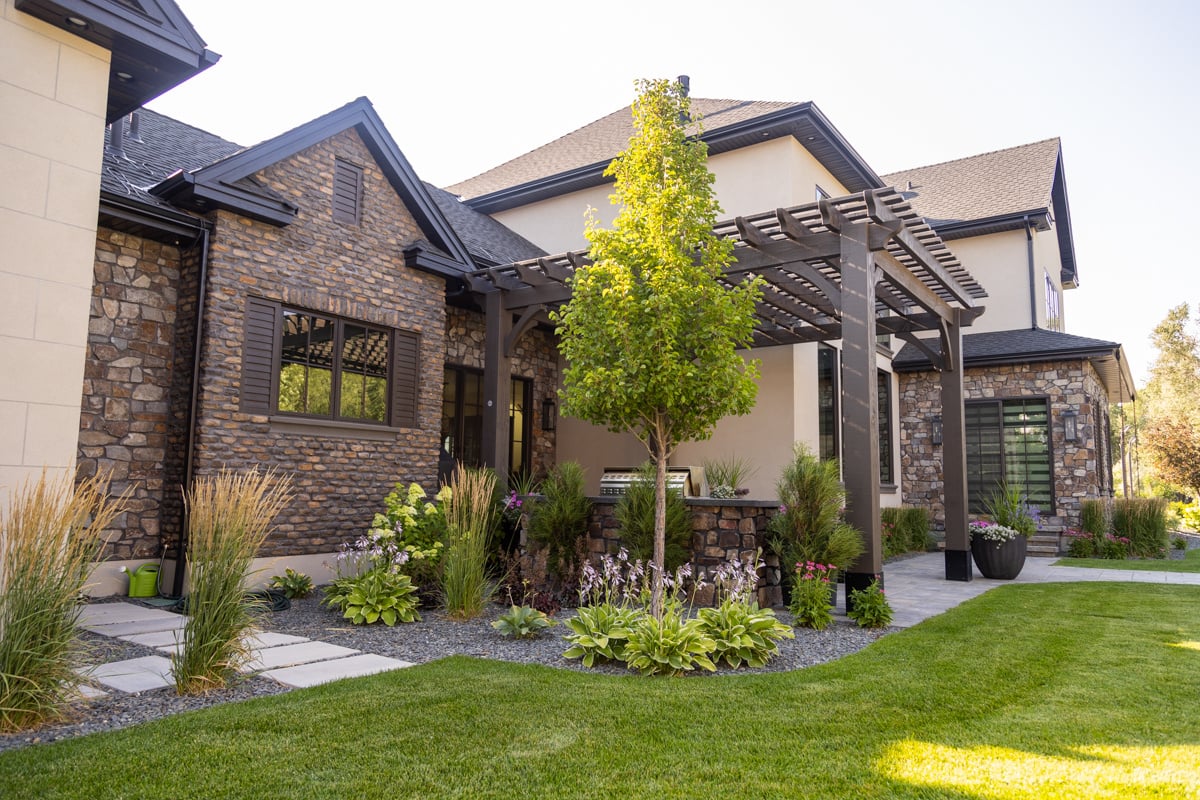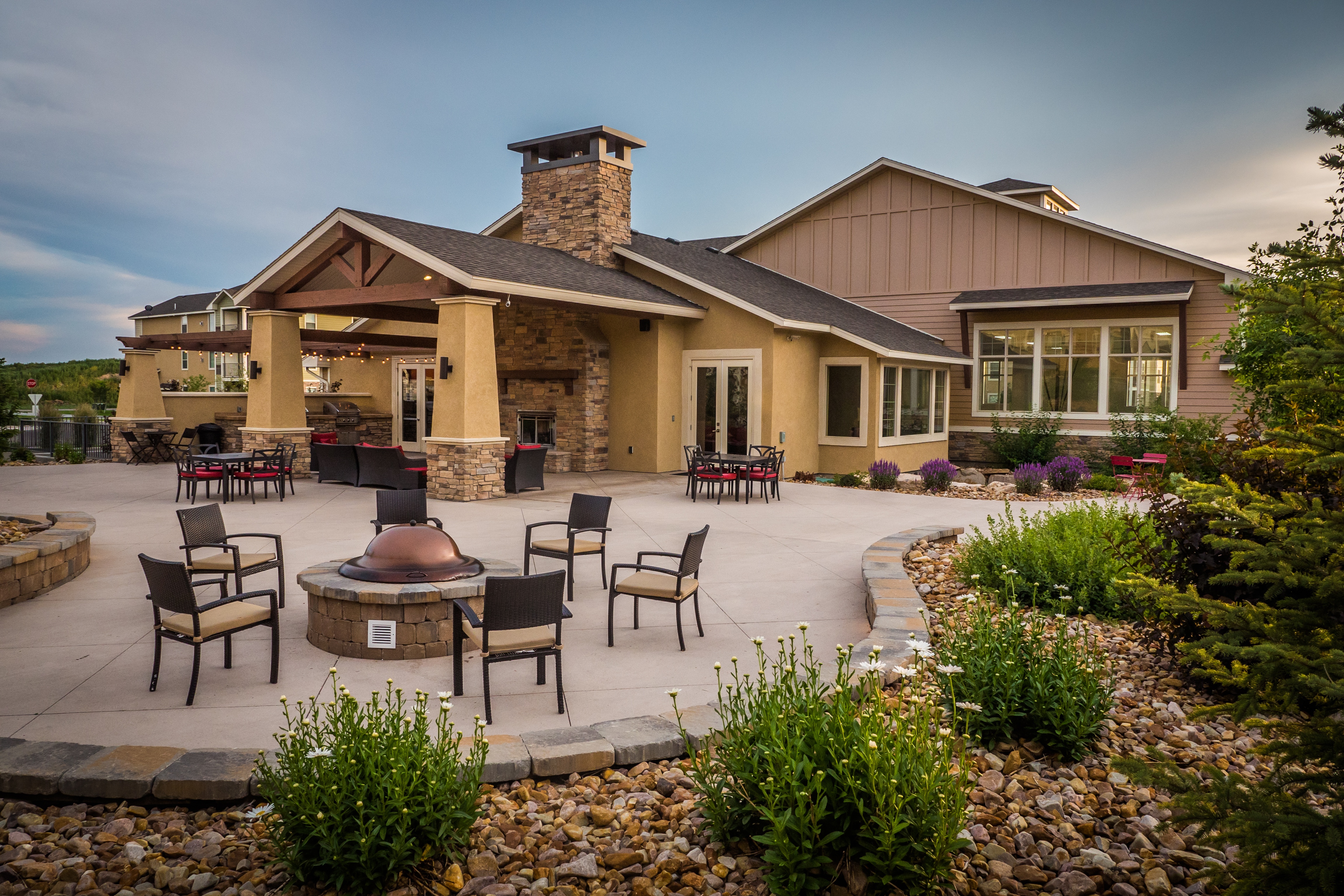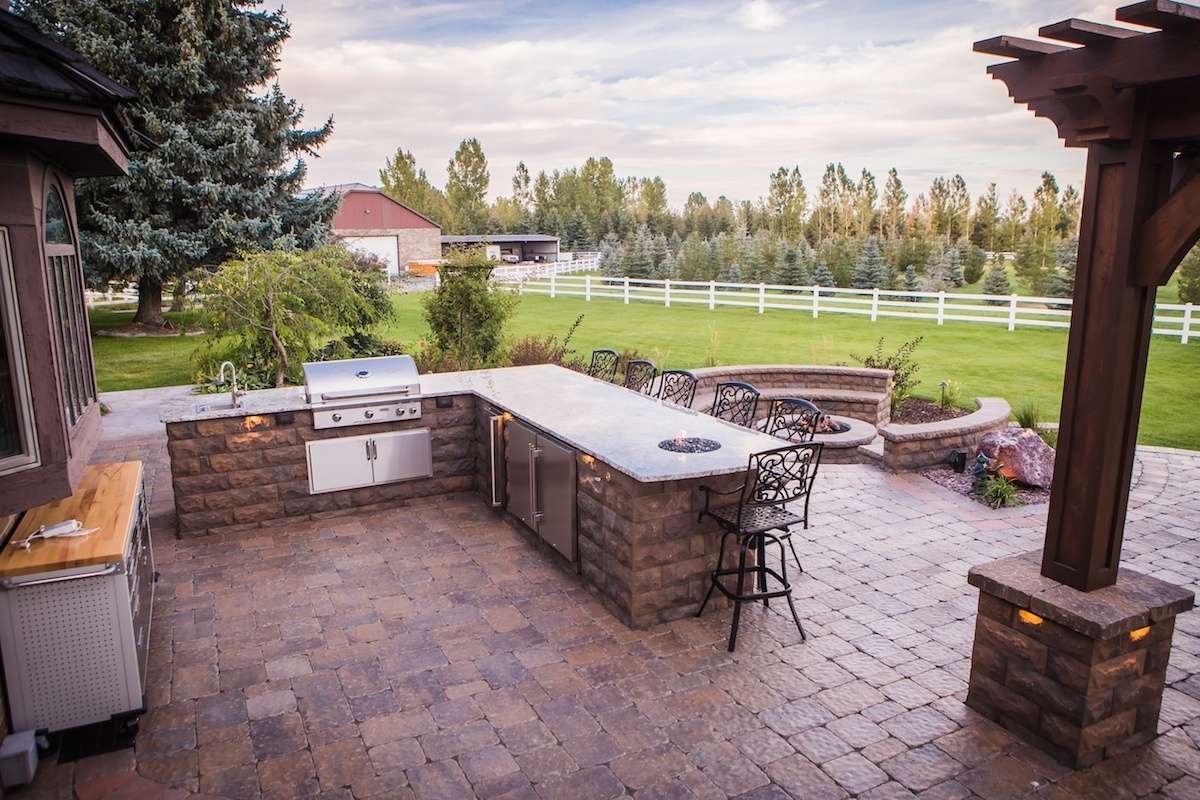

Using Commercial Landscape Design to Reduce Maintenance & Control Costs
Nobody sets out to have a nightmare high-maintenance landscaping project.
But sometimes it happens anyway, wasting money, using too much water and taking crews forever to keep it looking good.
The trick is to design your commercial property’s grounds to be low-maintenance in the first place.
Jump to Section
- How Does Landscape Design Impact Landscape Maintenance?
- Use Native and Drought-Tolerant Plants
- Replace Lawn with Low-Maintenance Materials
- Smart Irrigation Strategies Reduce Water Use
- Hardscaping for Durable, Low-Input Landscapes
- Limit the Variety of Plants
- Reduce Time-Consuming Pruning
- What Happens When You Take Over a High-Maintenance Commercial Landscape?
- How to Design a Low-Maintenance Commercial Landscape? Trust Outback
Be smart first, enjoy the rewards later.
How can you design a low-maintenance commercial landscape? Use native and drought-tolerant plants. Replace needy lawns with low-maintenance options. Use more hardworking hardscape. Add drip irrigation to save water and money.

Kirk Jeppesen, a landscape designer at Outback Landscape, shares his strategies for streamlined commercial landscape design and maintenance.
How Does Landscape Design Impact Landscape Maintenance?
More than you might think. The way you design a landscape sets the tone for how it works.
Plan a vast lawn, and you’ll need lots of irrigation, fertilizer, weed control and frequent mowing to keep it looking great.
But plan for easy-care ground covers, native plants, and decorative boulders, and cross that fussy lawn care off your list.
Keep using that irrigation system you had installed 12 years ago and you’re probably wasting water and money and scheduling a lot of frequent and costly repairs. Update your system with drip irrigation and strategically planned zones, and you spend less on watering.
You get the idea. Smart, strategic design saves time, maintenance and money.
Commercial grounds maintenance doesn’t have to be an expensive pain.
Check out Jeppesen’s go-to strategies:
1. Use Native and Drought-Tolerant Plants
Install plants in your commercial landscape design that can thrive with minimal care and limited water.
Native plants are varieties that originated in the area. They’ve always been here, so they’re automatically at home. Once they’re settled in, they need less water, fertilizer and maintenance than needy non-native plants.
“This significantly reduces irrigation needs and maintenance labor,” Jeppesen says.

Worried you’ll have to give up beauty for lower maintenance? Not a bit.
Idaho boasts some real stunners when it comes to native plants, with pretty flowers, attractive foliage and bright berries. Bonus: native plants attract beautiful birds and butterflies to your commercial property, and they help struggling pollinators who could use a helping hand.
2. Replace Lawn with Low-Maintenance Materials
A big expanse of lush lawn used to be the go-to feature for commercial landscape design, but that’s been changing.
Turf grass is needy, fussy and expensive to maintain. It’s not great for the environment, either, with all the mowing, fertilizing and watering.
The best commercial landscaping features go beyond grass.
“We often replace large, high-maintenance lawn areas with low-water ground covers, ornamental grasses, or mulch beds,” Jeppesen says. “This reduces mowing and irrigation costs while maintaining a polished appearance.”

Groundcovers add texture and color and help deter weeds. Ornamental grasses bring graceful movement to the landscape, and their fluffy seed heads add interest through fall and into winter.
Bark mulch not only makes your landscaping look tidy and complete, but it also does a ton of great things, from suppressing weeds to retaining moisture in planting beds to nourishing the soil as it breaks down over time.
3. Smart Irrigation Strategies Reduce Water Use
You’re probably wasting water without even realizing it. That means you’re wasting money on your landscaping budget.
Experts at the U.S. Environmental Protection Agency estimate as much as 50 percent of water used for landscape irrigation is wasted.
Smart irrigation planning from the beginning of your commercial landscape design can help address this issue.
“We use drip irrigation in shrub beds, and zone planning to align watering with plant needs,” Jeppesen says. “This avoids overwatering and minimizes issues like weeds and disease.”
What’s he talking about, exactly?
A Look at Drip Irrigation
Just as it sounds, drip irrigation slowly drips water from holes in tubing installed just below the ground or on the soil surface.
Instead of spraying water over large areas like sprinklers do, drip irrigation systems provide water to specific areas in your commercial landscape.
They target individual plants and their roots, rather than covering a wide space all at once.
You wouldn’t water a lawn this way, but it’s perfect for beds of plants and shrubs.
Irrigation Zone Planning
This irrigation strategy divides your landscaping into distinct areas, or zones, based on their specific watering needs.
Not all plants need the same amount of water. Zone planning involves grouping plants with similar needs together, then delivering precise water amounts to each area. Every plant gets enough water, but not too much.

As Jeppesen points out, overwatering doesn’t just waste water and money — it’s not good for your plants, either, often leading to ugly weeds and diseases.
It’s fairly common for commercial properties to water too much, he says.
“We try to cut back where we can.”
4. Hardscaping for Durable, Low-Input Landscapes
The best commercial landscaping features work hard, look great, and require minimal maintenance.
“Adding walkways, seating areas, or decorative xeriscaping can reduce maintenance while increasing the aesthetic appeal of the property,”Jeppesen says.
All these features look great, work hard for you, and need minimal maintenance.
Walkways and seating are self-explanatory, but xeriscaping might be new to you.

Xeriscaping is a landscaping design that minimizes the need for costly irrigation by utilizing drought-tolerant plants and other materials, such as gravel, rocks, and mulch.
These smart landscapes use less water and typically require less mowing, weeding, and fertilization. That’s easier on your landscaping budget.
If you’re skeptical that this approach to commercial landscape design looks barren and dry, we get it. Xeriscaping needs to be done right to look appealing. You can’t just spread a bunch of gravel, push a couple boulders into place and plant some cactus.
Put Jeppesen on the job and you’ll get a skilled and appealing design that might include rabbitbrush that bursts into color in the late summer with an impressive display of yellow flowers — and attracts bunches of pretty butterflies.
He might install dreamy drifts of lavender-blue Russian sage. Or sturdy and spectacular sea pink plants, covered with a profusion of pink flower clusters that bob atop sturdy stems.
Skilled xeriscaping can be stunning, featuring colorful flowering perennials, elegant ornamental grasses, intriguing textures, impressive decorative boulders, and artistic sculpture installations.
In the right hands, xeriscape isn’t just smart commercial grounds maintenance — it’s impressive, stunning commercial landscaping.
5. Limit the Variety of Plants
If your commercial landscaping boasts a diverse array of plants, people might mistake it for a botanical garden, but that’s not the point.
Keep it simple.
If you feature a mass planting of one knockout plant at your commercial property entrance, they all have the same streamlined maintenance needs, and if one or two die, landscape maintenance crews can easily replace them without any rearranging or time-consuming design.
“We try to keep the plant pallet simple to make it easier if something dies and needs to be replaced,” Jeppesen says.
6. Reduce Time-Consuming Pruning
Hand pruning is one of the most time-consuming tasks in commercial grounds maintenance. So Jeppesen takes steps from the beginning to limit the need for pruning later on.
The key? Proper spacing when plants are installed.

“We leave a lot of space for plants to grow naturally,” Jeppesen says. That way there’s plenty of room for plants to fill in nicely without frequent pruning battles to keep them from overgrowing their spots.
What Happens When You Take Over a High-Maintenance Commercial Landscape?
Jeppesen doesn’t always get to implement these smart strategies from scratch, as he designs landscaping. Outback often takes over existing commercial landscaping in Idaho Falls when they take on a new client.
If the builder installed the landscaping, it’s not typically designed with cost savings in mind for the landscape budget.
Many developers are required to install green elements as part of their buildout. But they’re not necessarily motivated to save you money on commercial landscaping costs. They install what’s required and move on to the next project.

So commercial landscaping companies like Outback are often faced with the challenge of maintaining landscaping that’s much more high maintenance than it should be, with needy grass, haphazard design and plants not suited for their spots.
“When we take over poorly planned commercial jobs, we always try to simplify them,” Jeppesen says. “A lot of the above strategies get incorporated over some time.”
The best way to ensure commercial landscaping costs stay low is to hire one skilled company to install and maintain these important spaces. That way landscape design pros like Jeppesen incorporate smart design strategies from the very beginning, to streamline costs.
Skilled maintenance crews are familiar with exactly what your property needs throughout the year to stay healthy and appealing.
How to Design a Low-Maintenance Commercial Landscape? Trust Outback
You have enough pressing demands on your list. Make sure your Idaho Falls commercial landscaping makes a great impression without creating a costly maintenance headache.
Partner with a skilled, experienced company that’s expert in smart, low-maintenance commercial landscape design and maintenance in Idaho Falls.
Say goodbye to high-maintenance landscaping, such as fertilizer-hungry lawns and thirsty flowers, which can run up your landscaping budget. The best commercial landscaping features use less water, need little maintenance and save you money while looking great.
We’d love to help.
Outback Landscape is a full-service landscaping company offering landscape design and commercial services in Boise and Idaho Falls. We install beautiful, functional landscapes and stay with you for the long haul, taking care of your property through all four seasons.
We serve residential and commercial properties in Idaho Falls, Rexburg, and Pocatello, Idaho, as well as the counties of Bonneville, Madison, and Bannock. Call us at 208-656-3220 or schedule a no-obligation meeting with one of our team members. We can’t wait to hear from you.
If You're Looking For a Sign, This is It.
Seriously, that lawn isn't getting any better on it's own. Mrs. Jones just called the HOA on you
.jpg?width=480&name=Chase%20Coates%20Team%20Portrait%202%20(2).jpg)
Chase Coates
Chase Coates is the owner of Outback Landscape in Idaho Falls, Idaho.


Brick Pavers vs Stamped Concrete: Pros, Cons, and Costs
.jpg)



